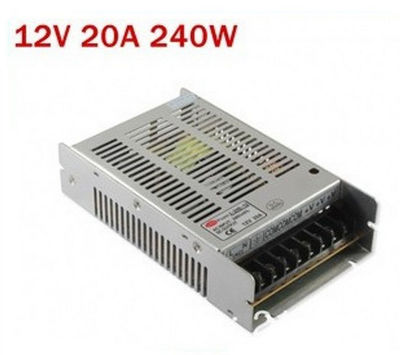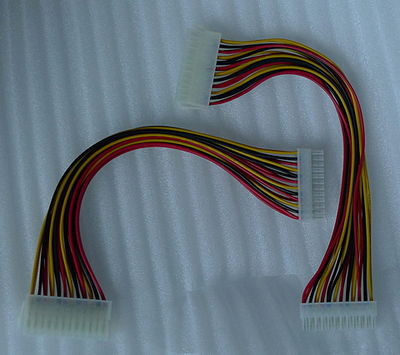Talk:Choosing a Power Supply for your RepRap
There are three different pages in this wiki that describe the use of switch-mode power supplies for RepRap 3D printers, and each of these pages takes a different approach to the problem:
- Choosing a Power Supply for your RepRap (this page) created in October 2014, reflects my opinions which are described below, based on my knowledge and my experience.
- PCPowerSupply created in July 2006, definitely puts the accent on re-using old AT/ATX PSU for RepRaps.
- Power Supply created in March 2011 basically shows how to use an LED strip PSU for a RepRap.
AndrewBCN 20/10/2014
First a disclaimer: I am not associated in any way with any power supply manufacturer and have no bias of any kind toward any particular brand.
The purpose of this page is to supplement the PCPowerSupply page in this wiki and eventually replace it with a newer, more up-to-date version.
A couple of remarks here: I am of the opinion that it is much better to buy a new inexpensive ATX PSU and modify it for RepRap use, than to buy a cheap LED strip PSU. Cheap LED strip PSUs are imho a safety hazard, much more so than a new inexpensive ATX PSU. I am appalled by the fact that some (actually, many) commercial RepRap kits and printers are sold with cheap LED strip PSUs!
BTW obviously none of the RepRap kit and printer sellers will describe the PSU included in their product as an "LED strip PSU", it will usually just be sold as an "OEM 12V switching power supply" with a given power rating. How many RepRap users are in a position and have enough information to question the performance, reliability and safety of a switching power supply? Not many, unfortunately.
Another personal opinion: reusing an old AT or ATX PSU (instead of spending $30 to $45 for an inexpensive but new ATX PSU) is a most unwise decision - a lesson I have learned the hard way! ATX PSUs are dust magnets, sleeve-type fans (the most common type in old PSUs) become noisy and ultimately fail (and when they do so during a print, you'll definitely smell smoke coming out of the PSU), and electrolytic capacitors fail catastrophically (with smoke and a bang), sometimes killing whatever electronics you have connected to the PSU. Not only that, but ATX PSU circuits have very much improved in performance, reliability and efficiency in the last couple of years (2013-2014), so the few dollars saved when reusing old ATX PSUs in RepRap projects are just not worth the risks, hassle and time wasted.
I will show later in this page:
1. What to look for in a new but inexpensive (by which I mean, within your budget) ATX PSU for your RepRap project. (Done 20-10-2014)
2. How to modify in a few quick steps an inexpensive ATX PSU for RepRap use. Any person with reasonable manual skills can do that in one evening.
3. Last but not least, a method to use the ATX PSU of your choice with any RepRap printer, that does not require any modification to the PSU and does not void its warranty.
- Excellent! However, I see you tend to duplicate stuff from the PCPowerSupply page. I'd remove this complicated lab PSU conversion there and insert these simpler instructions from here. --Traumflug (talk) 03:28, 21 October 2014 (PDT)
- Thanks! Will do. Since I am not finished with my write-up, I temporarily removed the lab PSU conversion there (I left a link to it in any case) and added a link to this page here.
AndrewBCN 22/10/2014
A couple of notes about the Tacens Radix Eco 500W ATX PSU that I am using as an example, before people jump on it thinking that I am recommending it (I am not):
- It is the least expensive ATX PSU with Passive PFC that I could find on Amazon.es, that is why I chose it to illustrate an ATX PSU conversion. But the truth is, it is just one notch above the cheap noname stuff.
- I honestly doubt this Tacens would be able to supply 500W in a continuous fashion even at room temperature. But the good thing is we only need about 240W from its 12V rail for our RepRap.
- I bought this Tacens ATX PSU just for RepRap use, but I would definitely not recommend it for any PC build (in fact I would not recommend this PSU brand at all).
- In Europe, I would most definitely recommend be quiet! ATX PSUs for RepRap use, or Corsair or Antec. Be quiet! PSUs have a very good price/performance ratio, and are extensively reviewed in German websites.
- In the US, again Corsair and Antec, but also Seasonic and XFX. All these brands manage to manufacture decent products even in their value lines.
I have used a be quiet! ATX PSU in the No Modifications example, it's a high quality PSU and you get what you pay for (Active PFC, Bronze efficiency rating, whisper quiet fan, etc).
AndrewBCN 22/10/2014
Here is an example of a cheap LED strip PSU which can be ordered from China for $18.95 (shipping included!):
Here is how the seller describes it:
12V 20A 240W switching power supply led strip light transformer
Input Voltage: AC110V-240V Output Voltage: 12V Power:240W
General Specification
Input Voltage: AC110V-240V
Output Voltage: DC 12v
Output Current: 0~20A
Net Weight: 500g
Dimensions: 200*112*51mm
Shell Material: Metal case / Aluminum case
Safety Compliance: CE /Rohs
High price-effective, reliability with industry standards
Built-in over voltage, over current, and short circuit protection
Working Temperature: 0~40C
Storage Temperature: -20~60C
Ambient Humidity: 0~95% Non-Condensation
The seller is honest enough to described it as an LED strip PSU - and that is exactly what it is. Note the absence of a fan, power cord and On/Off switch, no mention of PFC and no mention of over temperature or surge protections (none of which are really required for LED lighting purposes).
Again: I personally do not recommend the use of an LED strip PSU for RepRap projects. Even the low-end Tacens ATX PSU which I ordered from Amazon.es, was delivered in 48h to my door and cost me just a few euros more than this LED strip PSU, is a much better option imo. And the relatively inexpensive be quiet! ATX PSU which I am going to use in the No Modifications example is a way better option, of course, even though it costs almost twice as much as the Tacens.
If you cannot find a Tacens ATX PSU and cannot afford a be quiet! one, I have also tried a Techsolo TP-600 ATX PSU optimistically rated for 600W, it's a bit better built than the Tacens and costs more or less the same (also has passive PFC).
Update --AndrewBCN (talk) 06:50, 2 December 2014 (PST)
I finally received a pair of 24-pin extension cables so I can continue writing the "No Modifications" guide!
These were really cheap and as you'll notice, the wires are not color-coded :-( but they are good enough for their intended purpose.
I have moved this section here because it is vague and lacks enough information:
Low cost industrial grade alternatives
Recently (April 2015), several lower cost industrial grade switching power supplies have become available.
An excellent option missing - Used server power supplies
Hot-swap computer server power supplies are extremely well-designed and manufactured (you might say 'industrial grade'), compact, efficient (APFC), and available dirt-cheap on eBay for older server models. Most have had a nice low-dust life in a nicely cooled server room.
One could argue the 'hacking' required is much less than removing the captive wires in an ATX power supply, and safer - You can get away with not even opening the server supplies and access at the hot-swap connectors, hence never exposing your readers to mains-voltage risks.
The supplies from the likes of HP can be assumed to use top-quality components and design and safety throughout (Fires/Failures in a server room are very bad PR), and are hence worth many hundreds of dollars new, but available used for a few tens of dollars. I just picked one up from my work's IT junk pile that can supply 82.3 amps (no typo) at 12v.
I really think this is an excellent option for the 3D community and probably should be covered here. I'd boldy suggest maybe 'the preferred choice'. I would add some links, but I am not allowed yet. Try Googling like 'using a HP server power supply'. As you will see, the RC crowd are onto this for recharging their Lipos.
About the only down-side is that the fans (often 2-of for redundancy) err on the side of safety and tend to run fast and noisy. There are mods to address if this is a problem, but they tend to be very densely packed internally so maintaining significant positive airflow may be a good idea. Well, another downside is that the pinouts vary from PSU to PSU, and it may be tricky finding doco for some - Tricky but probably not impossible.
I hope you will consider adding to the already excellent information. Cheers - Peterg4000 (talk) 07:12, 16 October 2015 (PDT)

